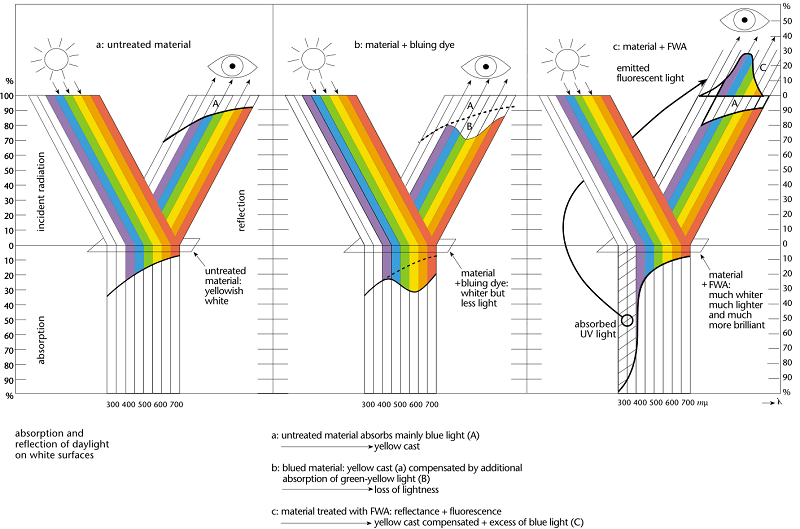Mechanism Of Optical Brightener
Optical brighteners or fluorescent whitening agents (FWAs) are colorless to weakly colored organic compounds that, in solution or applied to a substrate, absorb ultraviolet light and re-emit most of the absorbed energy as blue fluorescent light between 400 and 500nm.
 Materials that evenly reflect most of the light at all wavelengths striking their surface appear white to the human eye. Natural fibers, for example, generally absorb more light in the blue region of the visible spectrum (‘blue defect’) than in others because of impurities (natural pigments) they contain. As a result, natural fibers take on an unwanted, yellowish cast. Synthetic fibers also have this yellowish cast, although not as pronounced.
Materials that evenly reflect most of the light at all wavelengths striking their surface appear white to the human eye. Natural fibers, for example, generally absorb more light in the blue region of the visible spectrum (‘blue defect’) than in others because of impurities (natural pigments) they contain. As a result, natural fibers take on an unwanted, yellowish cast. Synthetic fibers also have this yellowish cast, although not as pronounced.
Whiteness in substrates can be improved by (1) increasing reflection (reflectance) or (2) compensating the blue defect.Bleaching has both of these effects to some extent, but invariably leaves behind part of the yellowish cast. Even the most thorough bleach cannot remove all traces of a yellowish cast.Before the advent of fluorescent whitening agents (FWA),common practice was to apply small amounts of blue or violet dyes (called ‘bluing’) to boost the visual impression of whiteness. These dyes absorb light in the green-yellow region of the spectrum, thereby reducing lightness. But, since at the same time they shift the shade of the yellowish material towards blue, the human eye perceives an increase of whiteness.
Unlike dyes, FWAs offset the yellowish cast and at the same time improve lightness because their bluing effect is not based on subtracting yellow-green light, but rather on adding blue light. FWAs are virtually colorless compounds
which, when present on a substrate, absorb primarily invisible ultraviolet light in the 300-400 nanometer (nm) range and re-emit in the visible violet-to-blue fluorescent light. This ability of FWAs to absorb invisible short wavelength radiation and re-emit in the visible blue light which imparts a brilliant whiteness to the light reflected by a substrate, is the key to FWAs effectiveness.
which, when present on a substrate, absorb primarily invisible ultraviolet light in the 300-400 nanometer (nm) range and re-emit in the visible violet-to-blue fluorescent light. This ability of FWAs to absorb invisible short wavelength radiation and re-emit in the visible blue light which imparts a brilliant whiteness to the light reflected by a substrate, is the key to FWAs effectiveness.